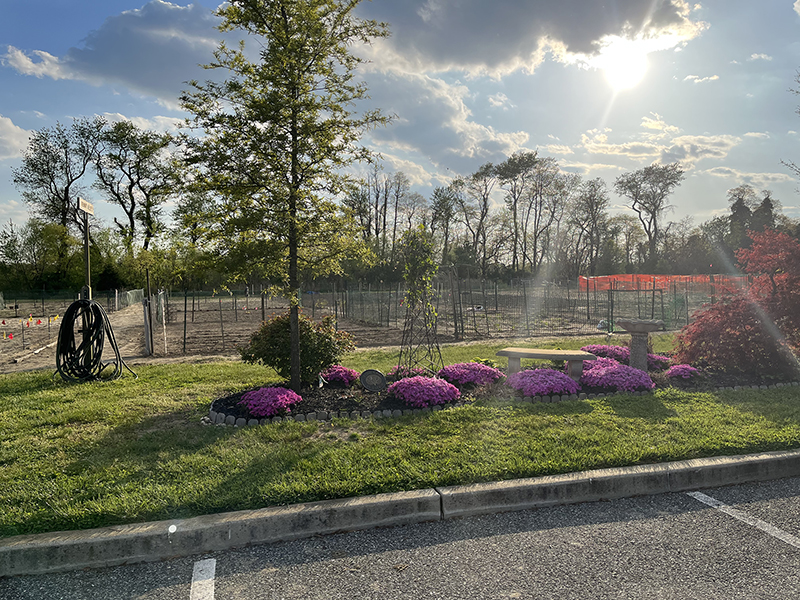Happy Spring!
April is National Gardening Month, and the towns hope that you sign up for the local community gardens this year. If you are interested in starting your own personal garden, this is the month to do it!
Gardening offers a plethora of benefits, both tangible and intangible, that contribute to overall well-being and environmental sustainability. According to a study published in the Journal of Public Health, gardening can significantly reduce stress levels and promote mental health, with 80 percent of gardeners reporting lower stress levels after spending time in their gardens.
The physical activity involved in gardening contributes to improved cardiovascular health and muscle strength, reducing the risk of chronic diseases such as obesity and heart disease.
Beyond personal health benefits, gardening also plays a crucial role in environmental conservation. Research from the National Gardening Association reveals that home gardens can sequester carbon dioxide from the atmosphere, mitigating the effects of climate as well. Additionally, gardens provide vital habitats for pollinators such as bees and butterflies, essential for maintaining biodiversity.
With these statistics in mind, it’s clear that gardening offers a multifaceted approach to enhancing both personal well-being and environmental sustainability, making it a rewarding and impactful activity for individuals and communities alike.
Are you interested in growing your own fruits and vegetables? Having a food garden isn’t just about veggies—it’s about community resilience. It’s like having a secret stash of fresh produce right in your backyard. When supply chains wobble or budgets tighten, having homegrown goods can save the day.
Plus, it’s a chance to ditch the mystery chemicals or get hands-on with what you eat. Think of it as a green oasis in our towns, teaching us all about sustainable living and bringing neighbors together over shared harvests.
Here are some tips on starting a vegetable patch.
*Planting Schedule: In early spring, cool-season vegetables like lettuce, spinach, peas, and broccoli can be planted. As the weather warms up, you can transition to warm season crops such as tomatoes, peppers, squash, and cucumbers. In April, there is a conducive environment for planting various fruits. Consider strawberries, blueberries, raspberries, and blackberries, which thrive in the region’s climate. Fruit trees like peaches, nectarines, and certain apple varieties can also be planted during this time.
* Soil Preparation: It’s essential to prepare the soil before planting. This may involve tilling the soil, adding compost or organic matter for nutrients, and ensuring proper drainage.
*Frost Awareness: Even though Spring has arrived, frost can still occur in our area. Keep an eye on the weather forecast and be prepared to protect tender plants with row covers or cloches if frost is predicted.
* Mulching: Mulching helps retain moisture in the soil, suppress weeds, and regulate soil temperature. Apply mulch around plants once the soil has warmed up sufficiently.
* Pest and Disease Management: Keep an eye out for common garden pests and diseases, such as aphids, caterpillars, and fungal infections. Consider using organic pest control methods to minimize damage to your plants.
* Watering: Spring can bring variable weather patterns, so be sure to water your garden regularly, especially during dry spells. Aim to water deeply and evenly to encourage healthy root growth.
* Pruning and Maintenance: Spring is a good time to prune fruit trees and shrubs, as well as to tidy up perennial beds. Remove dead or damaged branches and divide overcrowded perennials to promote vigorous growth.
* Companion Planting: Consider planting companion plants that can benefit each other by repelling pests, attracting beneficial insects, or improving soil health. Marigolds are excellent companions for tomatoes and peppers, helping to repel pests like aphids and nematodes. Nasturtiums act as decoys, diverting aphids away from your vegetables. Calendula attracts beneficial insects like ladybugs and hoverflies, providing natural pest control.
Sunflowers offer shade for heat-sensitive plants like lettuce and spinach while attracting pollinators. Bee balm attracts bees, enhancing pollination for fruits like strawberries and blueberries. Lavender repels mosquitoes and adds fragrance to your garden.
Consider planting Sweet Alyssum to attract beneficial insects like hoverflies and lacewings, which prey on aphids. By incorporating these companion flowers into your garden, you can create a more balanced ecosystem, leading to healthier plants and a more abundant harvest.
* Harvesting: Some early Spring crops like lettuce and spinach can be harvested as soon as they reach maturity. Continuously harvest crops like herbs and leafy greens to encourage more growth.
By following these tips, you can enjoy a successful spring gardening season in your backyard. Remember to adapt your gardening practices based on your specific location and microclimate. Each area can and will be different.
Not interested in fruits and vegetables? That is okay! There are plenty of flowers to grow as well. In April, gardeners can start growing a variety of flowers to add color and beauty to their gardens.
Annual flowers like marigolds, petunias, and impatiens are perfect for bringing vibrant hues to garden beds and containers. Perennials such as daylilies, coneflowers, and black-eyed Susans can be planted for long-lasting blooms year after year.
Bulbs like dahlias and gladiolus can also be planted now to enjoy their stunning flowers in the summer and fall. Native wildflowers like butterfly weed and purple coneflower are excellent choices for attracting pollinators while adding a natural touch to the garden.
Additionally, herbaceous perennials like lavender and sage can be planted for both visual appeal and practical use in cooking and crafts. With proper care and attention to soil preparation, these flowers will thrive and enhance the landscapes throughout the spring and summer months.
As we welcome the arrival of Spring, it’s the perfect time to celebrate the many advantages of planting flowers in our town. Beyond their visual appeal, flowers serve as essential contributors to our environment and overall well-being.
Picture-Perfect Landscapes: The addition of colorful blooms throughout our neighborhoods, parks, and public spaces enhances the aesthetic appeal of our town, creating welcoming environments for residents and visitors alike.
Supporting Local Pollinators: By cultivating a diverse range of flowers, we provide vital sustenance and habitats for bees, butterflies, and other pollinators. This not only aids in the health of our local ecosystem but also supports the pollination of nearby crops.
Preserving Biodiversity: A rich assortment of flowers encourages biodiversity by providing food and shelter for various wildlife species. This diversity contributes to the resilience and sustainability of our natural environment.
Promoting Mental Wellness: Spending time surrounded by flowers can have a positive impact on mental health, offering moments of tranquility and relaxation amidst the busyness of daily life.
Educational Opportunities: Engaging in gardening activities with flowers presents valuable learning opportunities for individuals of all ages. From understanding plant life cycles to learning about environmental conservation, there is much to discover and appreciate.
Improving Air and Water Quality: Flowers play a role in improving air quality by absorbing carbon dioxide and releasing oxygen through photosynthesis. Their presence also aids in water management, helping to reduce erosion and runoff in our community.
In essence, the act of planting flowers in our town goes beyond mere beautification—it fosters a deeper connection to nature, promotes ecological sustainability, and enriches the lives of everyone in our community. Let’s embrace the benefits of floral cultivation and continue to nurture our vibrant, blooming landscape.
If you do not have the space for a garden, garden beds are available for residents who wish to partake in community gardening efforts in both Woolwich and Swedesboro. These beds not only provide a platform for individuals to grow their own fresh produce but also serve as gathering spaces for neighbors to come together, share stories, and cultivate a deeper sense of community spirit.
By participating in community gardening initiatives, residents of Woolwich and Swedesboro can reap the rewards of fresh, locally grown produce, while also nurturing meaningful connections with our fellow community members. For information on the Woolwich Township Garden, please contact Eric Bennett at EricBennett1@aol.com. For information on the Swedesboro Auction Park Garden, please contact Jena Dolbow at jdolbow@swedesboro-nj.us.
As April brings in warmer weather and blossoming landscapes, it’s the perfect time to embrace the joys of gardening in our community. National Gardening Month invites us to connect with nature and each other through the beauty of blooms and the bounty of harvests. Whether you’re a seasoned gardener or eager to cultivate your green thumb, now is the time to dig in and get growing.
Gardening isn’t just about nurturing plants—it’s about fostering a sense of community resilience and environmental stewardship. As we plant seeds and tend to our gardens, we’re sowing the seeds of togetherness and sustainability.
As we celebrate the arrival of Spring and the abundance it brings, let us utilize the opportunity to connect with nature, nurture our community, and cultivate a greener, more vibrant future together. So, grab your gardening gloves, roll up your sleeves, and let’s make this April a month to remember in the garden!
By Monica Segeren







